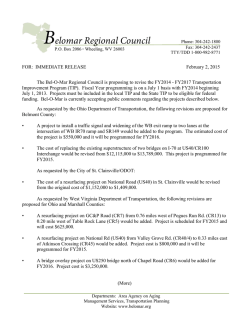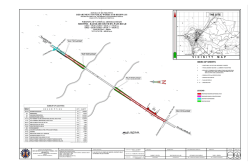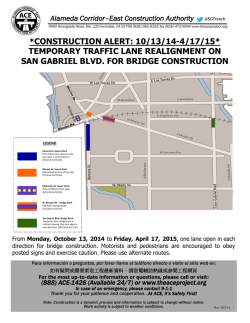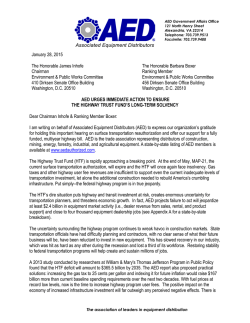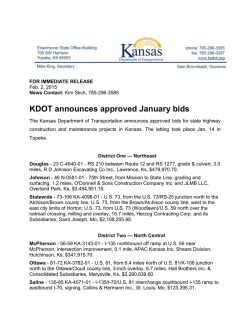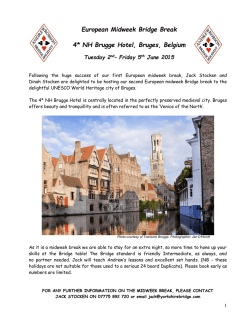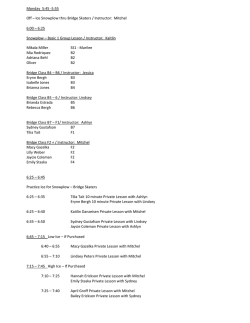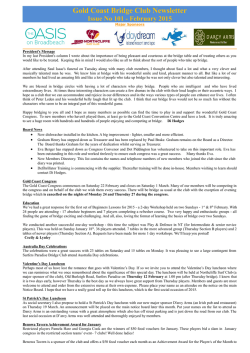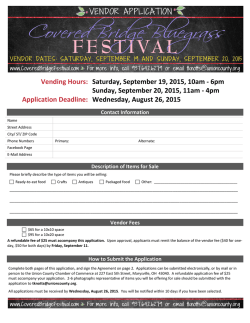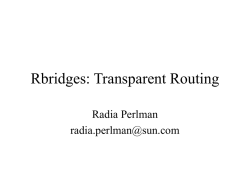
Presentation for 1 28 2015 final for Committee
1/28/2015 1. 2. 3. 4. Senate Transportation Committee Wednesday, January 28, 2015 5. How do MnDOT highway projects get selected? Managing Minnesota’s Bridges Managing Pavement Assets at MnDOT MnDOT Efficiencies Major Highway Projects and Trunk Highway Expenditure Report Minnesota GO 50-year Vision Desired Outcomes Statewide Multimodal Transportation Plan Guiding Principles Multimodal Objectives Strategies Nancy Daubenberger, P.E. State Highway Investment Plan Mode-Specific Strategies & Guidance Performance Measures & Performance-Based Needs Investment Optimization System Priorities & Definition Statewide Programs State specialists recommend a pool of projects using asset conditions & performance data Districts agree on projects from the pool considering regional concerns or suggest equal alternates District Programs District specialists identify projects based on performance data & regional/local concerns State specialists provide performance & asset condition data to assist the Districts Districts agree on a combined District program Districts and specialists agree on MnDOT program of projects to include in 10-Year Work Plan & STIP 1 1/28/2015 Area Transportation Partnerships Regional Development Commissions Metropolitan Planning Organizations Stakeholder workshop meetings Interactive websites A build-your-own budget calculator Webinars Social media ◦ Areas over 50,000 7 STIP (State Transportation Improvement Program) ◦ federally required ◦ includes federally funded projects on both the state and local system ◦ includes state funded projects on the state system ◦ updated annually Recommendations of asset management systems that maximize benefits for the investment. Projects result from specific engineering studies and regional plan priorities, and criteria include: ◦ Pavement smoothness ◦ Bridge condition ◦ Predictable, congestion-free travel option (MnPASS) ◦ Return on Investment ◦ Improve congestion with technology or operational improvements. ◦ Congestion and traffic volumes ◦ Crashes ◦ Lane continuity Achievement of plan outcomes and FHWA targets. Project continuity and timing coordination. Coordination with other state or local projects. 2 1/28/2015 Local government and public support Readiness (MnDOT and local partners) Return on Investment (cost/benefit analysis) Economic development potential Quality of life benefits. And others Safety Congestion Mitigation and Air Quality (CMAQ) Transportation Economic Development (TED) Corridors of Commerce Corridor Investment Management Strategies (CIMS) Managing Minnesota’s Bridges Assessment Bridge Inventory Safety Inspections Preservation Preventive Maintenance Reactive Maintenance Improvement Rehabilitation Replacement Nancy Daubenberger, P.E. Number of MN Bridges on File 2014 State County Township City State Park/State Forest Local Parks Railroad Private Federal Investments in the Life of a Bridge 20,671 4,846 8,548 5,347 1,223 114 122 273 183 15 23% 73% 3 1/28/2015 Interstate and State Bridges (>20’) ◦ Total Structurally Deficient – 2% ◦ 5 states better, 4 states tied, 41 states worse Interstate, State and City/County/Township Bridges (>20’) ◦ Total Structurally Deficient – 8% ◦ 21 states better, 6 states tied, 23 states worse * Source: “Better Bridges” Better Roads 2014 Bridge Inventory, November 2014; 51 states reporting. Program Changes Since 2007 Design QA/QC Limitations on Construction Loads Inspections/Ratings/Critical Findings Chapter 152 Bridge Program SIMS – Information Management & Maintenance Module BRIM – Bridge Risk Management System 4 1/28/2015 Trunk Highway Bridge Improvement Program created in 2008 Accelerated repair and replacement of trunk highway bridges throughout the state Now part of Chapter 165 statute, still referred to as the “Ch. 152 Program” in MnDOT Inventory bridges to include in the program All bridges on the trunk highway system in Minnesota that are classified: Fracture Critical Structurally Deficient A priority “Tier System” was also established Bridge Operations: Inventory and Inspection Status of the 172 Bridges: 94 substantially complete 8 others to be complete by end of 2015 construction season 35 scheduled to be under contract 2016 2018 32 were judged to need only routine maintenance 3 are privately owned or do not carry Trunk Highway traffic. Bridge SIMS State-of-the-Art Bridge Management Tool - Integrated Inspection and Maintenance Consistent Documentation and Reporting 5 1/28/2015 Inspection SIMS National Bridge Inspection Standards Inspection SIMS Bridge Safety Inspection Bridge Operations: Maintenance Load Ratings 6 1/28/2015 Maintenance Maintenance SIMS Identify Prioritize Schedule Complete Document Assess SIMS Management Resource and Scheduling Management Bridge Information vs. Maintenance Costs Investment Levels Preventive Bridge Maintenance Reactive Bridge Maintenance Bridge Operations: Emergency Response Emergency Response 7 1/28/2015 Emergency Response Inspection and Maintenance Training Bridge Planning and Programming Bridge Replacement and Improvement Management BRIM Bridge Replacement and Improvement Mgmt. WORSE • Inspection Details Condition Assessment • Condition Based Analysis • Risk Based Analysis • Bridge Programming Index (BPI) • Work Type • Cost Estimate Built 1995 or Later Built 1977 – 1994 PROBABILTY • Inventory Information LOW BRIM Built 1960 – 1976 Output Enhanced Bridge Improvement Planning HIGH • Time Frame Built Before 1960 HIGH BRIDGE CONDITION BETTER Structurally Deficient Deck Condition <= 5 Deck Condition <= 6 Deck Condition <= 7 Deck Condition <= 8 Any Deck Type N.A. Overlay within 20 Years Overlay within 25 Years Preventive Maintenance Preventive Maintenance Concrete Overlay Replace within 10 Years Rehabilitate within 20 Years Overlay within 10 Years Preventive Maintenance Preventive Maintenance No Concrete Overlay Replace within 10 Years Rehabilitate within 20 Years Overlay within 10 Years Overlay within 25 Years Preventive Maintenance Epoxy Deck Bars Replace within 10 Years Rehabilitate within 10 Years Preventive Maintenance Preventive Maintenance Preventive Maintenance Original Deck with Concrete Overlay – No Epoxy Bars Replace within 10 Years Rehabilitate within 10 Years Rehabilitate within 20 Years Rehabilitate within 25Years Preventive Maintenance Original Deck – No Concrete Overlay Replace within 10 Years Rehabilitate within 10 Years Rehabilitate within 10 Years Rehabilitate within 25Years Overlay within 20 Years Remodeled 1977 or Later Replace within 10 Years Replace within 10 Years Replace within 20 Years Preventive Maintenance Preventive Maintenance Deck Built Prior to 1977 Replace within 10 Years Replace within 10 Years Replace within 10 Years Replace within 25 Years Preventive Maintenance CONSEQUENCE LOW 8 1/28/2015 Risk-Based Bridge Planning Repair of Deteriorated Elements Truck Hit Evaluation of the Probability and Consequences of Bridge Risks. Critical Finding Glenn Engstrom, MnDOT Director, Office of Materials and Road Research Flood Damage Pathway Services© Pathrunner Digital Inspection Vehicle MnDOT measures the pavement condition of all State Highways on an annual basis. Testing involves driving each road, in both directions, and measuring the following: ◦ ◦ ◦ ◦ Pavement Roughness Rutting and Faulting Cracking and other pavement distress Digital images of the right-of-way and pavement surface Each year, approximately 21,000 lanemiles of state highways are driven. Typical Profile from the Pavement Van Ride Quality Index (RQI) An independent rating by an individual(s), i.e. customers. An indication of the roughness of a pavement on a 0 – 5 scale. Correlated to the van profile 5 4 3 2 1 0 VERY GOOD GOOD FAIR POOR VERY POOR 9 1/28/2015 Surface Rating (SR) Relates to the amount of surface distress (cracking, rutting, faulting, etc.) MnDOT has had pavement performance measures and targets since 2000 Typical Uses Ranges from 0 to 4 4 3 2 1 0 No Defects ◦ ◦ ◦ ◦ ◦ Report to top staff and legislators Estimate funding needed to achieve targets Compare the conditions of the 8 Districts Estimate the impact of potential funding proposals Track system trends Lots of Defects Prediction Models Pavement Roughness is predicted for each section of road based on it’s historical data Pavement projects are chosen primarily based on their condition (current, past, and future), age, and maintenance/construction history. Pavement engineers also look at other factors such as safety, maintenance needs, other nearby projects, etc. Projects on the National Highway System are chosen using a more centralized approach. Projects off the National Highway System are chosen more at the District level. 10 1/28/2015 Prediction Models The impact of future work can be predicted 1. Enter a predetermined program (list of projects) and see what the likely performance results are. 2. Enter anticipated budget and determine the most likely performance results. 3. Determine the funding needed to reach certain performance targets. Decision Trees are used to identify possible fixes for given conditions Each fix on the tree has an estimated cost Pavement Quality Index Each fix will result in an expected improvement and decay rate Minimum Acceptable Level Age The pavement data only reflects what is visible from the surface, not underlying issues or problems. Pavement management segments/recommendations may not result in logical project limits There are other factors to consider when identifying projects such as safety, mobility, maintenance history, utilities, etc. As a result of the data limitations, district pavement engineers and planners are consulted and help refine the list of projects including type of fix, estimated cost, and timing. There is a lot of back and forth communication that normally occurs before a project moves into the program. 11 1/28/2015 To demonstrate effective and efficient stewardship of public resources: ◦ Financial Management ◦ Asset Management ◦ Project Management Tracy Hatch Deputy Commissioner, CFO, COO Efficient stewardship comes in 3 categories: 1. 2. 3. The commissioner of transportation shall include in the report under Minnesota Statutes, section 174.56, due by December 15, 2015, information on efficiencies implemented in fiscal year 2015 in planning and project management and delivery, along with an explanation of the efficiencies employed to achieve the savings and the methodology used in the calculations. The level of savings achieved must equal, in comparison with the total state road construction budget for that year, a minimum of five percent in fiscal year 2015. The report must identify the projects that have been advanced or completed due to the implementation of efficiency measures. Analysis of efficiencies in an ongoing process ◦ Legislation required the Department to analyze project development pre-letting to find efficiencies for projects implemented in FY 2015 ◦ Doing project analysis for all projects $10M and over and let in 2015 Internal Cost Savings and Cost Avoidance: SRC, Maintenance & Operations, Agency Efficiencies External Direct Savings: user impacts or benefits; reduced detours, limited road closures External Indirect Impacts: economic impact – jobs created/supported Pre-Letting Current FY • MnDOT can influence • More real time / current savings • Savings within the program, reducing the cost of the project once let • Limited in project construction • Maintenance & Operations 2015 Goal – 5% Asset Life-Cycle Investment • Making the right investment at the right time saves money over frequent, and continuous, fixes. $60,250,000 To date (as of 1/27/2015) ◦ State Road Construction ◦ Maintenance & Operations ◦ TOTAL $36,800,000 $ 4,300,000 $41,100,000 12 1/28/2015 Primarily Pre-Letting ◦ ◦ ◦ ◦ ◦ ◦ Value Engineering Alternative Technical Concepts (post-letting) Design Optimization Contract Design Flexibility Innovative Delivery Methods Traffic Control Plan TH 24 - Replace Bridge 6557 Over Mississippi River in Clearwater, MN $5,550,000 I-90 - Unbonded Concrete Overlay/ Bituminous M+O (55 miles Total) I-35 - SB Unbonded Concrete Overlay (14 miles), Drainage and Guardrail TH 610 - Construct 4 Lane Freeway (2.5 miles), 9 Bridges and 3 Interchanges TH 10 - Unbonded Concrete Overlay (2 miles), Bridge at TH 59, Frontage Roads $2,810,000 TH 14 - Mill and Overlay (16 miles), Culverts, ramps, and Turn Lanes I-90 WB - Unbonded Concrete Overlay (12.2 miles), Br 85817, Culverts TH 14 - 2 to 4 lane Expansion and Nicollet Bypass (9 miles) and Bridge 52005 I-494 - 394 to the Fish Lake interchange, Pavement and Bridge Preservation/Rehabilitation, Improve Traffic Flow Annualized savings from M&O innovations Tow Plow: $490,000 Maintenance Decision Support System: $3,800,000 Automatic Flagger Assistance Devices: $13,000 $2,117,304 $12,689,449 $4,721,000 $334,500 $2,341,600 $4,500,000 $1,740,000 Savings were used to: ◦ ◦ ◦ ◦ Balance the FY 2015 program. Advance priority projects Convert Advanced Construction (AC) Fund Early Let Late Awards (ELLAs) The lessons learned from efficiencies identified for FY 2015 will lead to best practices the department plans to implement in overall program delivery. The report can be found at: http://www.dot.state.mn.us/govrel/reports.html The report includes the following sections: Tracy Hatch Deputy Commissioner, CFO, COO 1. Major Highway Projects Summary 2. Environmental Mitigation and Compliance Analysis 3. Trunk Highway Fund Expenditures 4. Systems Evaluations 5. Products and services budget and spending 6. Productivity measures 7. Project Summaries 13 1/28/2015 This report was completed to comply with Minn. Stat. 174.56 as amended by the Laws of Minnesota 2012, Chapter 287, Article 4, Section 48. Found on Pg. 4 of the Report Found on Pg. 11 of the Report Found on Pg. 19 of the Report Metro I-494 (Bloomington): Environmental mitigation costs were $0.35 million on $31.7 million project Greater MN Hwy 14 (Nicollet County): Environmental mitigation costs were $1.05 million on $22.4 million project Found on Pg. 15 of the Report Trunk highway fund expenditures by category FY 2014 (in millions) 1 2 3 4 5 6 7 8 9 10 Road construction Design and engineering Labor Acquisition of right of way Litigation Maintenance Road operations Planning Environmental compliance Administration Program Budget Activity Multimodal Systems Aeronautics Freight Pavement Management System Audit Passenger Rail Transit Bridge Management System Audit State Roads Trunk Highway Program Planning and Delivery Note: External Partner Support can occur in any of the products and services. Found on Pg. 21 of the Report Found on Pg. 58 of the Report $957.6 $198.4 $370.9 $65.9 $3.0 $95.1 $225.7 $13.6 $13.6 $88.0 Product and Service Airports Aviation Safety Operations and Regulation Commercial Truck and Bus Safety Freight Rail Improvements Freight System Planning Port Improvements Rail Crossing Safety Intercity Passenger Rail Improvement Bicycle and Pedestrian Planning and Grants Light and Commuter Rail Transit Planning and Grants Develop Highway Improvement Projects Highway Construction Management Oversight Plan Highway System Research and Development Trunk Highway State Road Construction Other Trunk Highway System Improvements Trunk Highway System Expansion Trunk Highway System Preservation Trunk Highway Debt Service Trunk Highway Operations and Maintenance Trunk Highway Debt Service Bridges and Structures Inspection and Maintenance Roadside and Auxiliary Infrastructure Snow and Ice System Roadway Structures Maintenance Traffic Devices Operation and Maintenance Statewide Radio Communications Local Roads County State Aid Roads Municipal State Aid Roads Radio Towers and Communications County State Aid Highway Municipal State Aid Highway 14 1/28/2015 Includes services such as: leave time, fleet support, buildings, building services and maintenance, finance and accounting, human resources and workforce relations, training, supervision, IT, inventory and equipment, legal services, government relations, audit, research, communication, citizen participation, customer relations, management and administration Found on Pg. 26 of the Report Found on Pg. 26 of the Report Bridges: ◦ Inspection cost per square foot of deck area ◦ Maintenance cost per square foot of deck area Pavement: Cost per additional roadway mileyear added Snow and ice: Cost per plow mile driven Pavement markings: Cost per mile striped Transit: MnDOT administrative cost per transit passenger trip Found on Pg. 40 of the Report • There is a slight upward trend in the square foot cost for bridge maintenance. • Possible contributors to the upward trend: increased funding through the HSOP program for bridge preventive maintenance; and an aging bridge system requires an increase in reactive maintenance Found on Pg. 45 of the Report • The cost per square foot for bridge inspections appears to increase over the time period analyzed, although more years of data are needed to accurately establish a trend • Bridge inspection expenses and cost per square foot peaked in fiscal year 2008 when the governor mandated accelerated inspections for all bridges. Found on Pg. 42 of the Report • The trend in cost per roadway mile-year added is decreasing over time. • Pavement is especially impacted by inflation since asphalt and concrete prices have increased disproportionately compared to other construction activities in recent history. Found on Pg. 48 of the Report 15 1/28/2015 • The cost per plow-mile driven has been stable over eight of the last 10 years. • Contributing to added efficiency are innovative technologies including tow plows, anti-icing, pre-wetting, de-icing, comprehensive snowfighter training and enhanced materials. Found on Pg. 51 of the Report • Striper cost per mile trends downward over the reporting period, though it fluctuate from year-to-year • Data is used by the striping unit to adjust standard practices and make operational improvements Found on Pg. 53 of the Report Major Project Summaries Found on Pg. 67 of the Report What projects are included: • Greater MN projects over $5 M* • Metro Projects over $15 M* • All projects planned and programmed for the next 15 years (projects beyond the STIP are displayed in a summary table with project cost ranges) • Projects are included in the report for 2 years after they have entered Substantial Completion • The MnDOT administrative cost per transit passenger trip has decreased over time • The unusually low administrative costs for 2011 are partially due to the state government shut down *2012 Legislation changed the thresholds expanding the number of projects included in this report. Found on Pg. 55 of the Report Major Project Summaries District 1 2 3 4 6 7 8 Metro State Projects Projects in completed, under Total years construction or projects 2019-2030 listed in the STIP 34 30 64 21 5 26 33 21 54 30 12 52 38 30 68 38 14 52 11 7 18 31 10 41 245 129 374 Major Project Summaries What information is being provided in the one page summary: • What we’re doing • Where we’re doing it • Why were doing it • How the project has changed over time • Cost and underlying assumptions • Risks • Key dates • Important project contacts 16 1/28/2015 Major Project Summaries Questions? www.mndot.gov Scott Peterson, Director of Government Affairs 651-366-4817 [email protected] 17
© Copyright 2025
